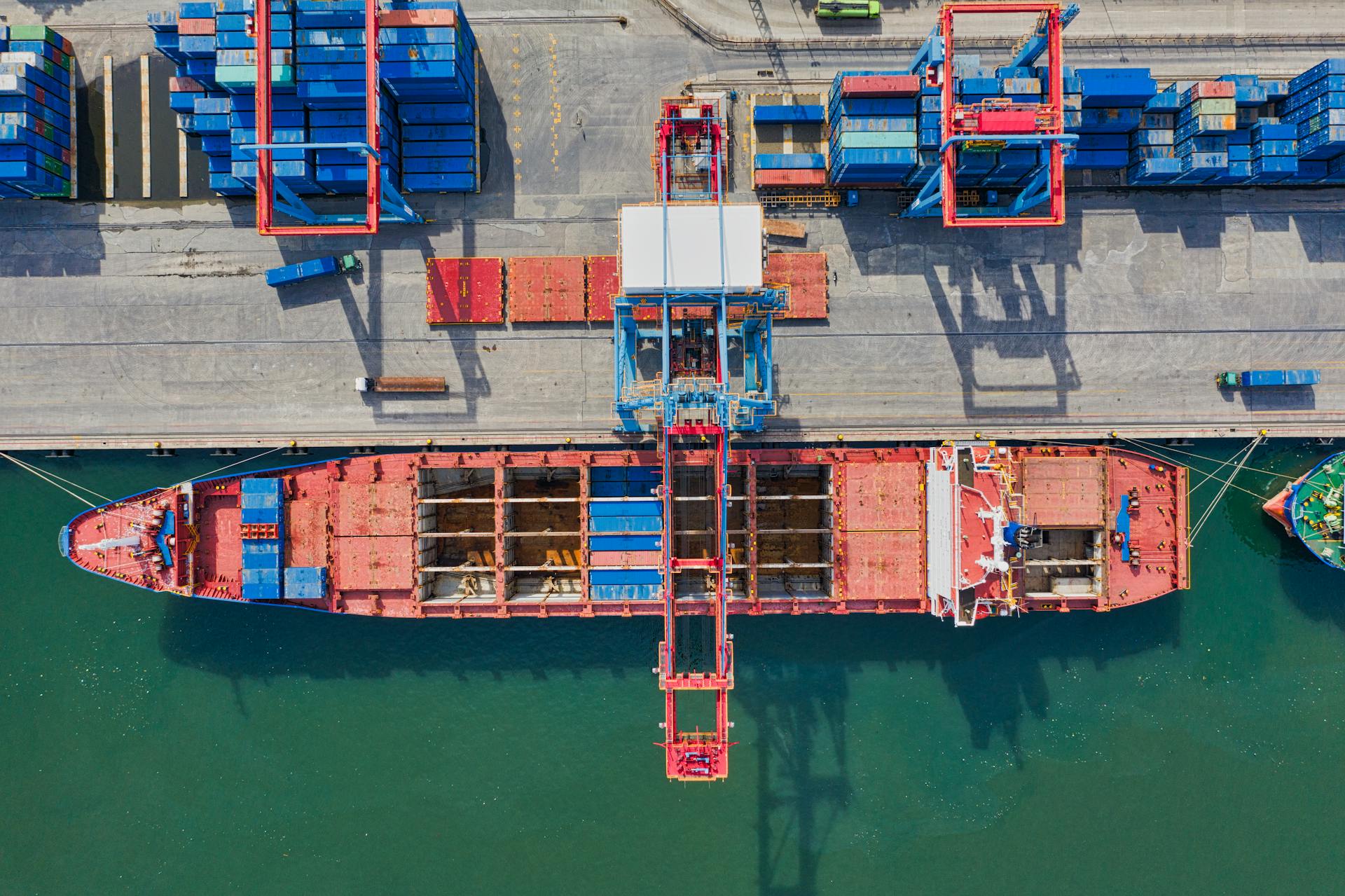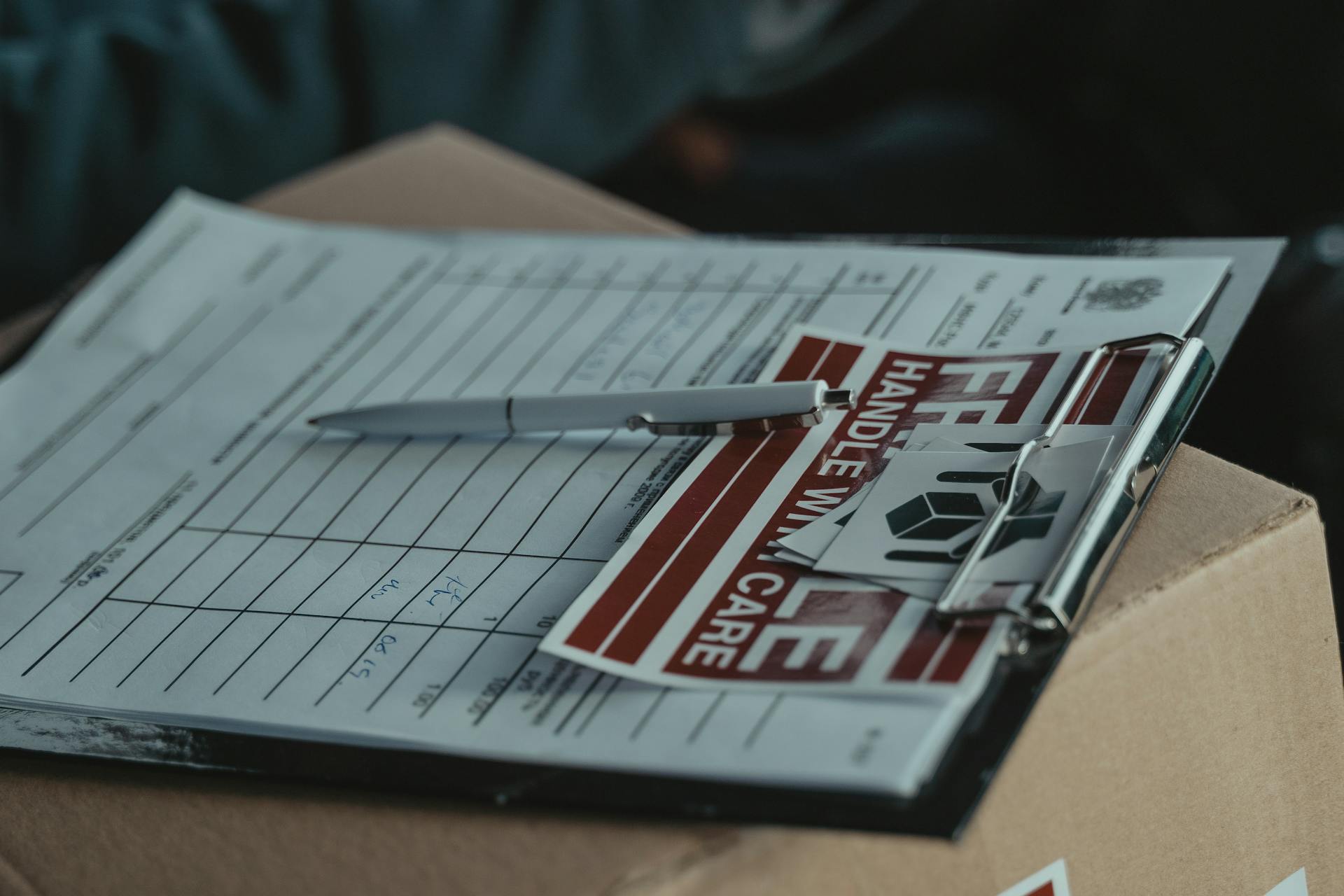
A bill of lading and a packing slip may seem like interchangeable documents, but they serve distinct purposes in the shipping process. A bill of lading is a legal document that confirms the receipt of goods by a carrier or freight forwarder.
It outlines the terms and conditions of the shipment, including the goods being transported, their weight, and the destination. A packing slip, on the other hand, is a document that lists the items being shipped, their quantities, and any relevant handling instructions.
Both documents are essential for ensuring that goods are delivered to the right person and in the correct condition.
You might like: Slip Sheets vs Pallets
Key Differences Between Bill of Lading and Packing Slip
The Bill of Lading and Packing Slip are two essential documents in international shipping, each with its own unique function. The Bill of Lading is issued by the carrier or freight forwarder and serves as a contract of carriage and evidence of the receipt of goods.
The Packing Slip, on the other hand, is usually provided by the seller or supplier and lists the contents of the shipment, helping with inventory management and ensuring that the correct items are delivered.
A key difference between the two documents is who issues them: the Bill of Lading is issued by the carrier or agent, while the Packing Slip is created by the shipper or seller.
Here's a summary of the key differences between the Bill of Lading and Packing Slip:
A Bill of Lading is a legally binding document that acts as a contract between the shipper and carrier, highlighting the terms and conditions of the shipment process. It's also known as evidence of a contract, while a Packing Slip is an informative document providing details related to the package, shipper, customer, and shipment process.
You might like: Shipper vs Consignee
Issuing Parties and Usage
A bill of lading is typically issued by a carrier, such as a shipping line or trucking company.
The carrier's role is crucial in ensuring the integrity of the document, as it serves as proof of ownership and contract of carriage.
A packing slip, on the other hand, is usually created by the shipper or seller.
This difference in issuing parties affects how the documents are used in different situations.
Issuing Parties
The carrier or their designated agent typically issues the Bill of Lading (BoL) once the goods are loaded onto the transport vehicle.
This ensures that the BoL is issued after the goods are loaded, and it's a crucial document for verifying the shipment's contents and details.
The carrier or their designated agent is responsible for issuing the BoL, which is a standard practice in the industry.
This process helps prevent any discrepancies or issues that may arise during the shipping process.
In contrast, the seller or shipper generates the packing slip, which is included with the shipment for the buyer or consignee to verify its contents upon receipt.
The packing slip is a separate document from the BoL, and it serves a different purpose in the shipping process.
Suggestion: Paper Slip Sheets
Transporters Use When

Transporters use a packing slip when they handle shipments that require verification of contents upon delivery. This is especially important in cases where packages are damaged or lost during transit, as a packing slip can document the shipment's contents.
Transporters should also use a packing slip when handling shipments that need to be verified upon delivery. This ensures that the contents match the documentation.
Importance and Impact
The bill of lading and packing slip are two essential documents in the shipping process, and understanding their importance and impact is crucial for businesses and individuals alike.
A bill of lading is a contract between the shipper and the carrier, outlining the terms of the shipment, which can significantly impact the shipping process, as seen in the example of the "Bill of Lading vs Packing Slip: What's the Difference?" section.
The accuracy and completeness of a bill of lading can affect the delivery of goods, as it serves as a receipt for the goods and a contract for the sale of the goods. The bill of lading also plays a crucial role in facilitating the transfer of ownership of the goods.
A packing slip, on the other hand, is a document that accompanies the shipment and provides detailed information about the contents of the package, which is essential for tracking and verifying the shipment.
Importance of the

The importance of a Bill of Lading cannot be overstated, as it serves multiple roles in international freight. It acts as a contract between the shipper and the carrier, outlining the terms of transporting goods.
A Bill of Lading provides a receipt that confirms the carrier has received the goods in good condition. This is crucial for both parties involved in the transaction.
The Bill of Lading is a vital document that outlines the terms of transportation, including the destination, mode of transport, and expected delivery date. This information is essential for the consignee to plan and prepare for the arrival of their goods.
It also serves as a proof of ownership and a way to track the goods throughout the transportation process. This helps to prevent loss or damage to the goods during transit.
Discover more: Carrier Liability vs Cargo Insurance
Shipping and Receiving Impact
The bill of lading (B/L) is crucial for both shipping and receiving, defining the responsibilities of all parties and playing a significant role in resolving disputes, particularly in case of loss or damage during transit.
A packing slip is primarily used by the shipper to ensure that the correct items are included in the shipment, but it doesn't have the same legal weight as a B/L.
Having a clear B/L can save a lot of headaches down the line, as it helps to prevent misunderstandings and miscommunications between shippers and receivers.
The B/L is a vital document that outlines the terms of the shipment, including the type and quantity of goods, the shipping method, and the delivery date.
In contrast, a packing slip is more of a checklist for the shipper, ensuring that all the necessary items are included in the shipment, but it's not a legally binding document like the B/L.
Using Bill of Lading and Packing Slip Together
You can use both documents in tandem to maximize their benefits. This is especially helpful in cross-referencing, where the packing slip can serve as a reference for the recipient to verify the shipment contents against the bill of lading.
In many scenarios, using both documents together can provide a layered approach to risk management. The bill of lading offers legal protection, while the packing slip aids in accurate order fulfillment.
The packing slip can be used for internal record-keeping and organizing shipments, while the bill of lading can be shared with external parties for legal and contractual purposes. This helps streamline the shipping process and ensures everything runs smoothly.
Suggestion: Is It Legal to Ship a Firearm in Us Mail
Kapan Harus Memprioritaskan
Prioritizing between a bill of lading (B/L) and a packing slip depends on your specific shipping needs, the nature of your business, and the legal and logistical requirements involved in your shipping processes.
In domestic shipping and less complex supply chain environments, packing slips are often sufficient for internal record-keeping and verifying the contents of a package.
For businesses that need to maintain detailed inventory records, packing slips can play a role in inventory management by providing a record of items shipped and received.
Using both documents in tandem can maximize their respective benefits, such as cross-referencing and internal and external use, especially when shipping valuable, fragile, or regulated goods.
Functions and Core Elements
A bill of lading and a packing slip are two crucial documents in the logistics industry, but they serve different purposes. A bill of lading acts as a receipt for goods and provides title to the goods in the shipment process.
The core elements of a bill of lading typically include the shipper, consignee, goods being transported, and detailed information about the items being shipped. This ensures smooth cargo movement and provides essential information for all parties involved in the shipping process.
A packing slip, on the other hand, contains important information about a shipment, including the sender's details, SKU numbers, weight and size, quantity and units, and goods being transported. It also includes special instructions, packaging details, and special handling requirements.
Here are the key elements of a packing slip:
- A detailed description of goods
- Sender and receiver contact information
- Order number
- Unit quantity: the number of units of one product or multiple products within a package.
- Kind of packing: the type of packing, like cartons or pallets.
- Net weight (kg): the summed weight of the product, excluding the package.
- Gross weight (kg): the combined weight of the product and package.
Both documents are essential in ensuring that shipments are completed correctly and that all parties involved have the necessary information to manage the delivery process efficiently.
Difference and Detail
A bill of lading is generally issued by the carrier or agent once goods are loaded into the shipment vehicle.
The issuing party for a packing slip, on the other hand, is the shipper or seller, who attaches it to the shipment packages so that buyers can verify the delivery.
A bill of lading is a legally binding document that acts as a contract between the shipper and carrier, highlighting the terms and conditions of the shipment process.
A packing slip, by contrast, is an informative document that provides details related to the package, shipper, customer, and shipment process.
Here's a comparison of the two documents:
The primary goal of a packing slip is to verify shipment contents, track the order, clear customs, and build trust between the shipper and the customer.
Difference Between
When you're dealing with international trade transactions, understanding the difference between key documents is crucial. A bill of lading is a legally binding document that acts as a contract between the shipper and carrier, highlighting the terms and conditions of the shipment process.

The issuing party is another key difference. A bill of lading is generally issued by the carrier or agent once goods are loaded into the shipment vehicle, while a packing slip is created by the shipper or the seller and attached to the shipment packages.
A packing slip typically contains information like a detailed description of the product, its weight and quantities, the order number, and the contact information of the sender and receiver. This focus on shipment contents is essential for verifying the delivery and building trust between the shipper and the customer.
The purpose of a bill of lading is to ensure a smooth and on-time delivery process, while a packing slip aims to verify shipment contents, track the order, clear customs, and build trust between the shipper and the customer.
Here's a comparison of the two documents in a nutshell:
- Bill of Lading: issued by carrier or agent, legally binding, focuses on transportation aspect
- Packing Slip: created by shipper or seller, informative, focuses on shipment contents
In summary, understanding the unique functions of these documents is essential for smoother international trade transactions.
Detail Informasi

Detail Informasi is a crucial aspect of international trade, and it's essential to understand the difference between BOL and Packing Slip. BOL, or Bill of Lading, contains detailed shipping information, including the route, payment requirements, and insurance.
The BOL is a comprehensive document that outlines the terms of the shipment, including the goods being transported, the mode of transportation, and the expected delivery date. Packing Slip, on the other hand, focuses solely on the details of the goods being shipped, without any information about the shipping process or contractual requirements.
For businesses and small-scale entrepreneurs involved in international trade, it's vital to utilize services like import and export facilitation from PT Surya Inti Primakarya to streamline their operations.
Broaden your view: Food Packing for International Travel
Frequently Asked Questions
Can a packing list be used as a bill of lading?
A packing list cannot be used as a bill of lading, as they serve distinct purposes with different information. A packing list provides details about the goods, whereas a bill of lading represents the title of ownership.
Sources
- https://www.inboundlogistics.com/articles/bill-of-lading-vs-packing-slip/
- https://ship4wd.com/shipping-documents/bill-of-lading-vs-packing-slip-difference
- https://cargox.io/content-hub/bill-of-lading-vs-packing-slip-key-differences-and-roles-in-shipping-and-logistic/
- https://nextbillion.ai/glossary/bill-of-lading-vs-packing-slip
- https://sip-exim.co.id/news/articles/bill-of-lading-vs-packing-slip
Featured Images: pexels.com


